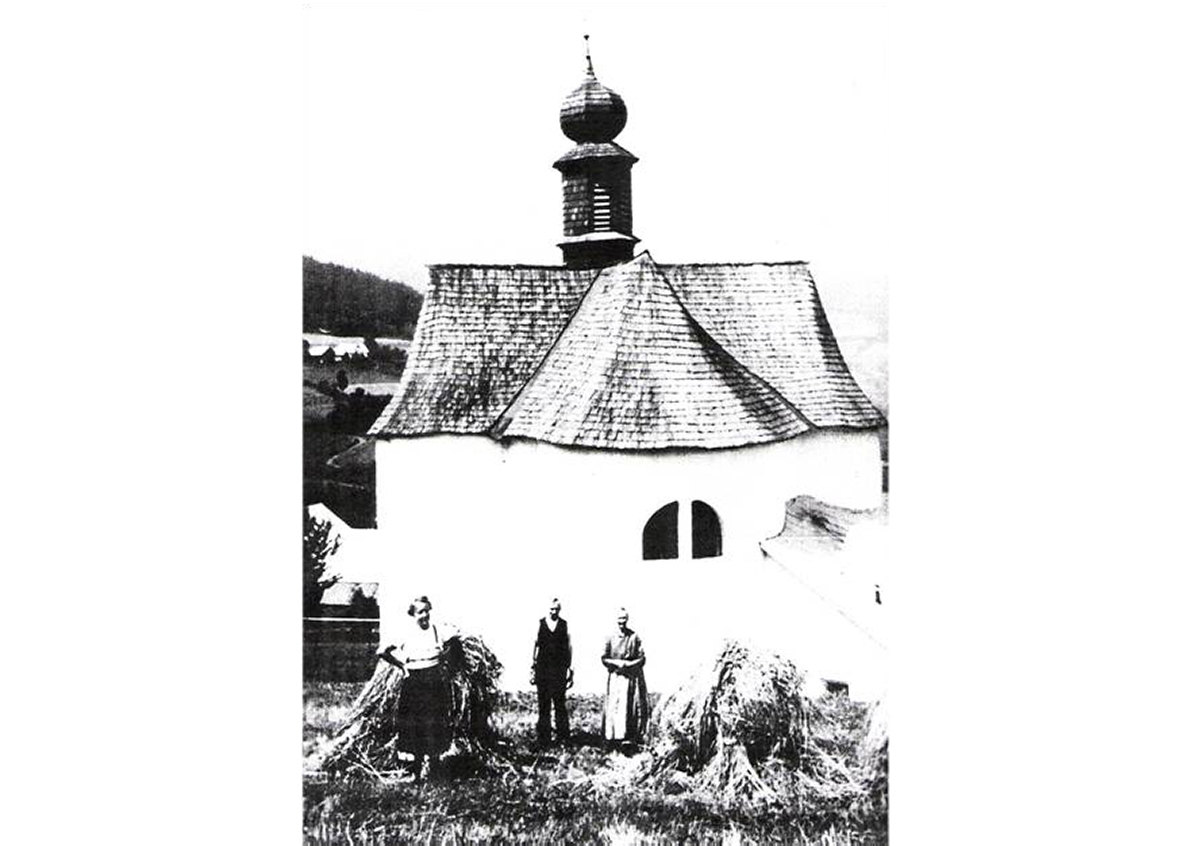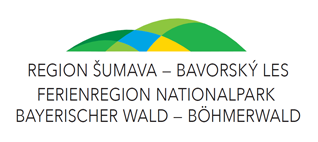4 – Pilgrimage site Křížkov
In the Úhlava valley, on the northern foothill of Královský forest, there used to stand a small village. It was a local part of Hamry, scattered across the area of around three and a half thousand hectares. There used to be an impenetrable dense forest, until hammer mill workers and ore transporters stumped it. The dominant of the village was a small chaple dedicated to Our Lady of Sorrows.
The chapel in this place, called Kreuzwinkel in German, was built by Johann Torner between 1730 and 1731. This is confirmed by a stone board with the year 1731 and the coat of arms of the House of Kolowrat-Krakow from Újezd (the shield in the coat of arms is divided into two halves, with a crowned eagle on the right and a unicorn on the left), which was originally placed above the chapel’s entrance and now stands in the place of the main altar. In this chapel, sometimes called Heilig-Kreuz-Kirchlein, there were three wooden rococo altars with acanthus leaves. Since 1736, a twenty-centimetre silver pax with remains of the Holy Cross used to stand on one of them. It was a gift from Kateřina Knittel from Prague. The pax had an oval, slightly wrought stand, which ended in a baroque board covered with tiny pressed ornaments with gilded glow. There was also a copy of the Infant Jesus of Prague. Older residents say it was given to the chapel by duchess Elisabeth Kolowrat (née Lobkowicz, 1580–1663, died in Žichovice), the wife of the supreme magister Jindřich Kolowrat-Libštejn. She fell ill and lost both sight and hearing. It is said that she regained her full health after kissing the Infant Jesus. After that, she became a great devotee to the Infant Jesus, had a copy made and donated it to the chapel.
The chapel had a cross-shaped ground plan with semi-circular apsidal. The middle of the ground plan was square shaped, adjoined on the western side to an entrance hall with a choir. The other sides each opened into a semi-circular apsidal with semi-circular windows. From outside, it was plain, without decorations, covered by a shingle roof with an onion dome tower on the western side. Two bells hung in the tower; one from 1730 reading GOSS NICOLAVS LÖW IN PRAG ANNO 1.7.3.0. and a newer, bigger one from 1839.
The chapel in this place, called Kreuzwinkel in German, was built by Johann Torner between 1730 and 1731. This is confirmed by a stone board with the year 1731 and the coat of arms of the House of Kolowrat-Krakow from Újezd (the shield in the coat of arms is divided into two halves, with a crowned eagle on the right and a unicorn on the left), which was originally placed above the chapel’s entrance and now stands in the place of the main altar. In this chapel, sometimes called Heilig-Kreuz-Kirchlein, there were three wooden rococo altars with acanthus leaves. Since 1736, a twenty-centimetre silver pax with remains of the Holy Cross used to stand on one of them. It was a gift from Kateřina Knittel from Prague. The pax had an oval, slightly wrought stand, which ended in a baroque board covered with tiny pressed ornaments with gilded glow. There was also a copy of the Infant Jesus of Prague. Older residents say it was given to the chapel by duchess Elisabeth Kolowrat (née Lobkowicz, 1580–1663, died in Žichovice), the wife of the supreme magister Jindřich Kolowrat-Libštejn. She fell ill and lost both sight and hearing. It is said that she regained her full health after kissing the Infant Jesus. After that, she became a great devotee to the Infant Jesus, had a copy made and donated it to the chapel.
The chapel had a cross-shaped ground plan with semi-circular apsidal. The middle of the ground plan was square shaped, adjoined on the western side to an entrance hall with a choir. The other sides each opened into a semi-circular apsidal with semi-circular windows. From outside, it was plain, without decorations, covered by a shingle roof with an onion dome tower on the western side. Two bells hung in the tower; one from 1730 reading GOSS NICOLAVS LÖW IN PRAG ANNO 1.7.3.0. and a newer, bigger one from 1839.

The church underwent several reconstructions.
In 1863, Eduard Hanner wrote to his patronage office that “as far as the tower goes, the wooden construction was completely redone by Mr Linsmaier, owner of land in Kreuzwinkel, with his own financial means. It is not in need of further repairs and the wood is coated in red oil paint…”
According to a 1866 report from Bystřice, all faults of the chapel were dealt with using 655 golden pieces and 22 kreuzers. The princely high chamber kindly donated 200 golden pieces and the parish priest Meerwald gathered 400 golden pieces in donations.
Pastor Mathias Bendik from Hamry asked prince Wilhelm von Hohenzollern for money to renovate the filial church in Hamry, arguing that it is very old, much older than the parish church in Hamry and has a remain of Christ’s cross, as well as an artistic historical treasure in the beautiful handcrafted frame of the main altar painting. He also states that the church’s own capital is usually swallowed completely by its yearly needs as there are two ceremonial services a year, as well as the holy Mass. It is visited by loggers from the area, from Osserwald and Seewald. Six to eight Kreuzwinkel landowners have an interest in preserving the church. Parishioners then organised a fundraiser which raised about 1200 crowns. The estimated prise of renovation being 1700 crowns.
The church underwent a general repair in 1935.
It was demolished in 1958. A partial rebuilding happened in 2007 thanks to the cooperation of Hamry and the association of German natives Künische Gemeinde Hammern and the Bavarian village of Lam, with financial support from the European Union (initiative of INTERREG III.A program). Today, partly preserved walls, a part of stone floor and the abovementioned stone board are all that’s left. The pilgrimage site was consecrated by the general vicar of the Pilsen bishopric Mons. Dr. Robert Falkenauer, in the present of Czech and German pastors on July 14, 2007.
A six meter high wooden cross was erected and an information board set up.
In 1863, Eduard Hanner wrote to his patronage office that “as far as the tower goes, the wooden construction was completely redone by Mr Linsmaier, owner of land in Kreuzwinkel, with his own financial means. It is not in need of further repairs and the wood is coated in red oil paint…”
According to a 1866 report from Bystřice, all faults of the chapel were dealt with using 655 golden pieces and 22 kreuzers. The princely high chamber kindly donated 200 golden pieces and the parish priest Meerwald gathered 400 golden pieces in donations.
Pastor Mathias Bendik from Hamry asked prince Wilhelm von Hohenzollern for money to renovate the filial church in Hamry, arguing that it is very old, much older than the parish church in Hamry and has a remain of Christ’s cross, as well as an artistic historical treasure in the beautiful handcrafted frame of the main altar painting. He also states that the church’s own capital is usually swallowed completely by its yearly needs as there are two ceremonial services a year, as well as the holy Mass. It is visited by loggers from the area, from Osserwald and Seewald. Six to eight Kreuzwinkel landowners have an interest in preserving the church. Parishioners then organised a fundraiser which raised about 1200 crowns. The estimated prise of renovation being 1700 crowns.
The church underwent a general repair in 1935.
It was demolished in 1958. A partial rebuilding happened in 2007 thanks to the cooperation of Hamry and the association of German natives Künische Gemeinde Hammern and the Bavarian village of Lam, with financial support from the European Union (initiative of INTERREG III.A program). Today, partly preserved walls, a part of stone floor and the abovementioned stone board are all that’s left. The pilgrimage site was consecrated by the general vicar of the Pilsen bishopric Mons. Dr. Robert Falkenauer, in the present of Czech and German pastors on July 14, 2007.
A six meter high wooden cross was erected and an information board set up.
